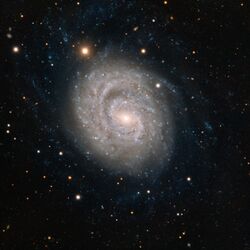Astronomy:NGC 1637
| NGC 1637 | |
|---|---|
 Very Large Telescope image of NGC 1637. | |
| Observation data (J2000 epoch) | |
| Constellation | Eridanus |
| Right ascension | 04h 41m 28.229s[1] |
| Declination | −02° 51′ 28.94″[1] |
| Redshift | 0.00239[2] |
| Helio radial velocity | 717.1±1.2 km/s[2] |
| Distance | 9.77 ± 1.82 Mpc (31.9 ± 5.9 Mly)[3] 9.18 Mpc (29.9 Mly) h−10.73[4] |
| Apparent magnitude (V) | 11.5[5] |
| Apparent magnitude (B) | 11.25[6] |
| Characteristics | |
| Type | SAB(rs)c[3] or SBc(s)II.3[7] |
| Apparent size (V) | 4.0′ × 3.2′[5] |
| Other designations | |
| AGC 440323, LEDA 15821,[8] PGC 15821[5] | |
NGC 1637 is an isolated, non-interacting[7] intermediate spiral galaxy in the constellation Eridanus, about a degree to the WNW of the star Mu Eridani.[9] It is located at a distance of about 9.77 ± 1.82 Mpc (31.9 ± 5.9 Mly) from the Milky Way.[3] The galaxy is inclined at an angle of 31.1° to the line of sight from the Earth and the long axis is oriented along a position angle of 16.3°.[3]
In 1991, Gérard de Vaucouleurs and associates assigned a morphological classification of SAB(rs)c to NGC 1637, indicating a spiral galaxy with a weak bar structure (SAB) across the nucleus, surrounded by a partial ring (rs) and somewhat loosely-wound arms (c).[7] While the inner section of the galaxy shows a symmetrical two-arm structure,[6] it has a single outer spiral arm that wraps 180° around the nucleus,[6] giving the galaxy an overall asymmetric, lopsided appearance.[7] The outer spiral arm has a red component that indicates a significant age.[6] However, the existence of this structure is difficult to explain.[7] The galaxy shows indications of recent starburst activity that may have terminated around 15 million years ago.[6]
The active central nucleus shows weak LINER behavior, and it may be an intermediate form between a LINER and an H II region.[7] The luminosity of the X-ray source at the nucleus is 1.2×1038 ergs s−1 in the 0.3–7 keV band.[6]
A type II-P core collapse supernova was discovered during October 1999, at an angular separation of 24″ to the southwest of the galaxy center. It received the designation SN 1999em and was the brightest supernova discovered that year, reaching magnitude 13.1.[10] The location corresponds to a deprojected galactocentric separation of 1.3 kpc (4.2 kly).[3]
File:Zooming in on the spiral galaxy NGC 1637 eso1315a.ogv
References
- ↑ 1.0 1.1 Skrutskie, Michael F.; Cutri, Roc M.; Stiening, Rae; Weinberg, Martin D.; Schneider, Stephen E.; Carpenter, John M.; Beichman, Charles A.; Capps, Richard W. et al. (1 February 2006). "The Two Micron All Sky Survey (2MASS)". The Astronomical Journal 131 (2): 1163–1183. doi:10.1086/498708. ISSN 0004-6256. Bibcode: 2006AJ....131.1163S.
- ↑ 2.0 2.1 Haynes, Martha P. et al. (January 1998). "Asymmetry in High-Precision Global H i Profiles of Isolated Spiral Galaxies". The Astronomical Journal 115 (1): 62–79. doi:10.1086/300166. Bibcode: 1998AJ....115...62H.
- ↑ 3.0 3.1 3.2 3.3 3.4 Crowther, Paul A. (January 2013). "On the association between core-collapse supernovae and H ii regions". Monthly Notices of the Royal Astronomical Society 428 (3): 1927–1943. doi:10.1093/mnras/sts145. Bibcode: 2013MNRAS.428.1927C.
- ↑ "NASA/IPAC Extragalactic Database". Results for NGC 1512, Co-Moving Radial Distance. http://nedwww.ipac.caltech.edu/.
- ↑ 5.0 5.1 5.2 "NASA/IPAC Extragalactic Database". Results for NGC 1637. http://nedwww.ipac.caltech.edu/.
- ↑ 6.0 6.1 6.2 6.3 6.4 6.5 Immler, Stefan et al. (October 2003). "A Deep Chandra X-Ray Observation of NGC 1637". The Astrophysical Journal 595 (2): 727–742. doi:10.1086/377474. Bibcode: 2003ApJ...595..727I.
- ↑ 7.0 7.1 7.2 7.3 7.4 7.5 Sohn, Young-Jong; Davidge, T. J. (January 1998). "VRI CCD Photometry of Supergiant Stars in the Barred Galaxies NGC 925 and NGC 1637". The Astronomical Journal 115 (1): 130–143. doi:10.1086/300163. Bibcode: 1998AJ....115..130S.
- ↑ "NGC 1637". SIMBAD. Centre de données astronomiques de Strasbourg. http://simbad.u-strasbg.fr/simbad/sim-basic?Ident=NGC+1637.
- ↑ Sinnott, Roger W.; Perryman, Michael A. C. (1997). Millennium Star Atlas. 1. Sky Publishing Corporation and the European Space Agency. ISBN 0-933346-84-0.
- ↑ "Bright Supernovae - 1999". Astronomy Section, Rochdale Academy of Science. http://www.rochesterastronomy.org/snimages/sn1999/.
External links
 |

